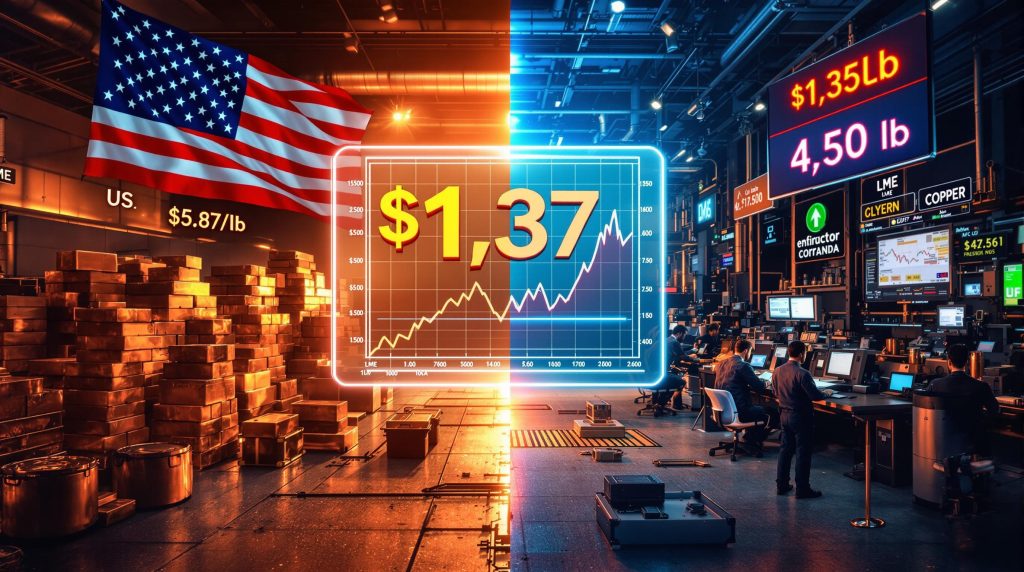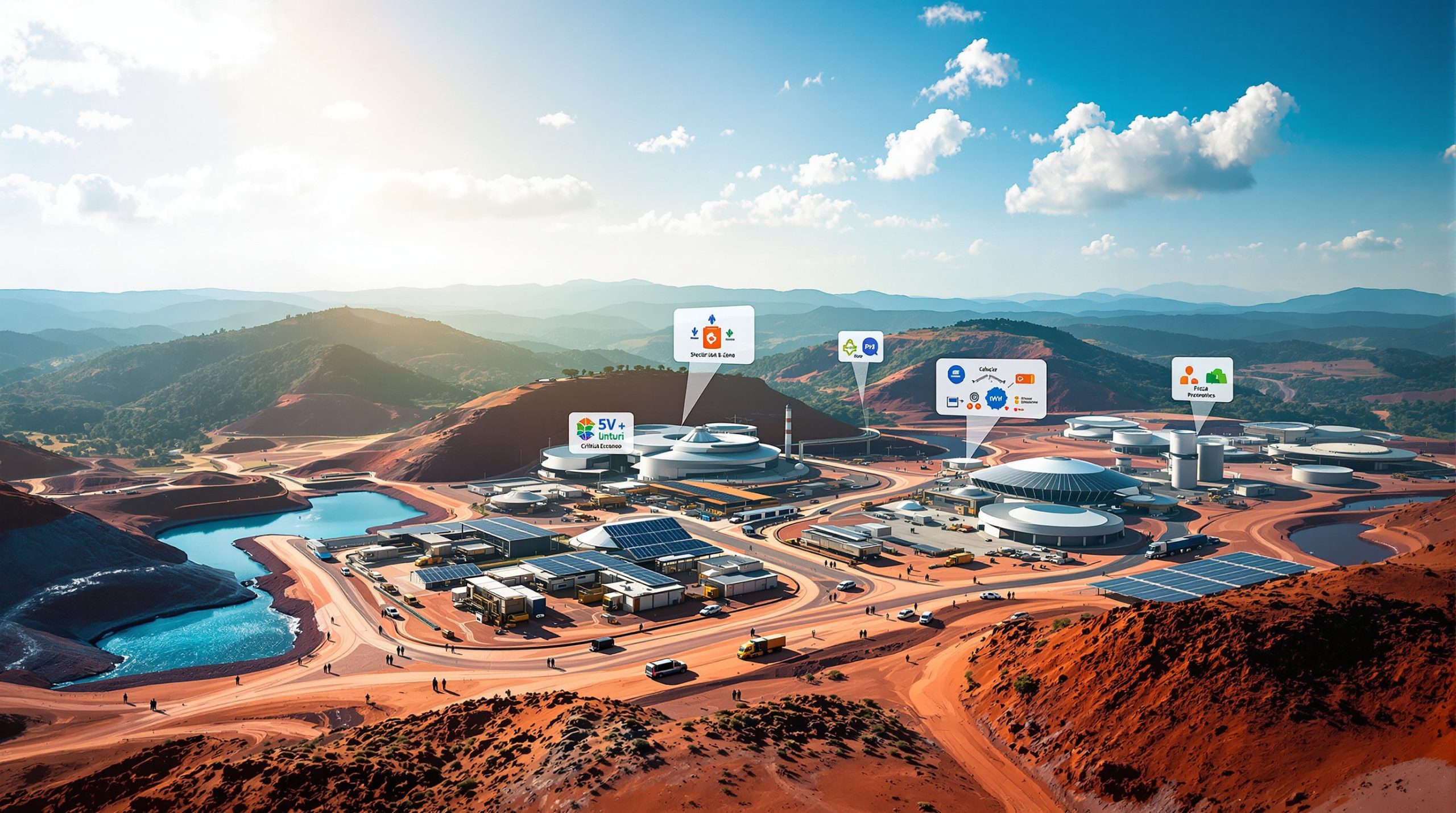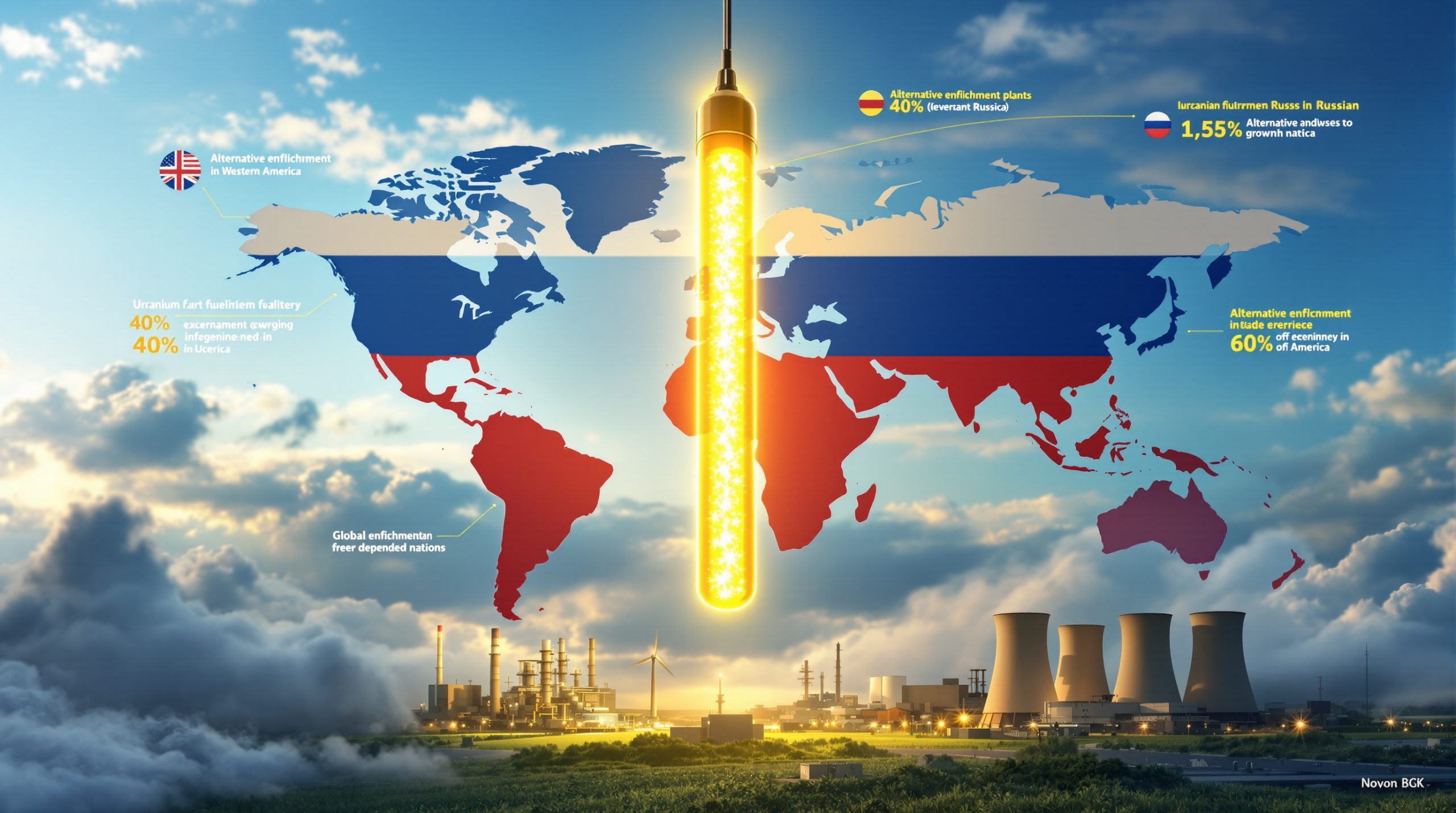How Has the US Copper Tariff Transformed Global Markets?
The implementation of a 50% tariff on copper imports to the United States has fundamentally altered global copper trade dynamics, creating unprecedented market fragmentation and copper price predictions. This policy shift has established a domestic premium of approximately 30% over London Metal Exchange (LME) prices, representing one of the largest sustained arbitrage spreads in base metals history.
According to industry experts, the copper market has never experienced such a dramatic bifurcation, with price differentials persisting beyond initial market adjustments. This suggests structural rather than temporary market changes are taking hold.
Market Bifurcation and Price Disparities
The tariff has created two distinct copper markets with significant price differentials:
| Market | Current Price | Premium/Discount |
|---|---|---|
| COMEX (US) | $5.87/lb | +30% premium |
| LME (Global) | $4.50/lb | Baseline |
| Price Spread | $1.37/lb | Largest in base metals history |
This price divergence has triggered rapid shifts in trading patterns, inventory movements, and strategic positioning among market participants. COMEX copper inventories have decreased by nearly 65% since the tariff announcement as traders rush to capitalize on domestic premium pricing.
Notably, physical delivery premiums in US markets have reached historic highs, with Midwest premium assessments showing 3-4× increases compared to pre-tariff levels. This has created substantial arbitrage opportunities for traders with existing inventory positions.
Strategic Implications Beyond Trade Policy
The copper tariff represents more than just a trade barrier—it signals copper's elevation to strategic resource status within national security frameworks. This policy aligns copper with other Section 232-targeted commodities like steel and aluminum, reflecting growing recognition of copper's critical role in:
- Electrification infrastructure and grid resilience
- Renewable energy systems and storage technologies
- Advanced defense applications requiring high-conductivity materials
- Domestic manufacturing resilience in critical technology sectors
Interestingly, the Department of Defense has classified certain high-purity copper specifications as "strategic materials" with specific domestic sourcing requirements, further elevating copper's status beyond industrial commodity.
What Opportunities Have Emerged from Market Fragmentation?
The unprecedented bifurcation between US and global copper markets has created multiple arbitrage and strategic opportunities for well-positioned market participants. The most significant value creation potential exists for companies with physical positioning advantages and operational flexibility.
Arbitrage and Trading Strategies
The substantial price differential between US and global markets has created multiple arbitrage opportunities for traders with:
- Physical inventory capacity in tariff-exempt locations
- Cross-border logistics capabilities for optimized routing
- Financing access for inventory holding during arbitrage execution
- Hedging expertise to manage price risks across fragmented markets
Major trading houses have begun strategic inventory accumulation, particularly in bonded warehouses at key transit points. This indicates expectations that price differentials will persist rather than representing temporary market dislocations.
Some traders have developed complex "triangular arbitrage" strategies involving multiple jurisdictions to optimize tariff positioning while maintaining physical delivery capabilities. These approaches yield 12-18% returns on deployed capital even after accounting for transportation and financing costs.
Supply Chain Restructuring
Traditional copper trade routes are undergoing significant restructuring as market participants adapt to the new tariff environment:
- Chilean and Peruvian exports face economic barriers to direct US shipments, with many cargoes being redirected to Asian markets
- Canadian and Mexican producers gain competitive advantages through USMCA exemptions, commanding premium pricing while avoiding tariff impacts
- Domestic US producers capture premium pricing without increased production costs, significantly enhancing operational margins
- Processing and semi-fabrication activities are relocating to circumvent tariff impacts, with particular growth in Mexico and Canada
The tariff has accelerated vertical integration strategies among downstream consumers, with several major manufacturers acquiring minority stakes in copper mining operations to secure supply chain control.
Jurisdictional Advantages
The tariff has created clear winners and losers based on geographic positioning:
Advantaged Regions:
- North American copper investments (especially Canada and northern Mexico)
- Domestic US miners and processors with established operations
- Mexican copper operations with USMCA benefits and proximity advantages
- Projects in politically stable jurisdictions with clear regulatory frameworks
Disadvantaged Regions:
- Chilean and Peruvian exporters facing direct tariff impacts
- Asian refiners dependent on US markets for balance sheet optimization
- Projects in politically uncertain jurisdictions facing compounded risks
- Operations with high carbon intensity facing dual ESG and tariff barriers
Companies with operations spanning multiple jurisdictions have begun strategic production shifting to maximize tariff-advantaged output while maintaining optimal utilization across their asset portfolio.
Why Has Copper Become a Strategic Resource?
Copper's transition from industrial commodity to strategic resource reflects its central role in energy transition technologies, national security applications, and critical infrastructure resilience. This status elevation has significant implications for resource security policies.
Energy Transition as Demand Driver
Copper's strategic importance continues to grow due to its essential role in the global energy transition:
- The International Energy Agency projects a 40% increase in copper demand by 2035, driven primarily by electrification technologies
- Electric vehicle production requires 2.5-4× more copper than conventional vehicles (approximately 180-220 pounds per EV)
- Renewable energy systems use 4-12× more copper than traditional power generation, with solar requiring 5.5 tons per megawatt and wind 4.3 tons per megawatt
- Grid modernization demands substantial copper for transmission and distribution upgrades (approximately 5,500 tons per gigawatt of renewable capacity)
The energy transition alone is projected to create 9.7 million metric tons of additional annual copper demand by 2035 according to industry forecasts. This represents almost half of current global copper supply forecast.
National Security Considerations
The tariff policy reflects growing recognition of copper's national security implications:
- Critical infrastructure resilience depends on secure copper supply chains for grid hardening and redundancy
- Defense applications require high-purity copper with specific performance characteristics for advanced weapons systems
- Technology manufacturing relies on copper for semiconductor packaging, thermal management, and connectivity
- Grid hardening initiatives demand substantial copper resources to protect against physical and cyber threats
Military specifications now mandate domestically-sourced copper for several sensitive applications, with exemptions requiring extensive security clearance processes. This represents a fundamental shift in copper's strategic classification within defense procurement frameworks.
Supply Constraints and Geopolitical Factors
The strategic revaluation of copper coincides with growing supply constraints:
- Declining ore grades at existing mines reduce production efficiency (global average grades have fallen from 2.5% to 0.7%)
- New project development faces extended permitting timelines (now averaging 8-12 years from discovery to production)
- Water constraints limit production in key copper regions, particularly in Chile's Atacama Desert
- Political instability affects major producing regions, with resource nationalism concerns in several key jurisdictions
Global copper mine production growth has averaged just 2.1% annually over the past decade despite significant price incentives, indicating structural supply constraints beyond cyclical factors.
How Are Mining Companies Positioned in This New Environment?
The tariff-induced market fragmentation has created significant valuation and operational differentials among copper producers based on jurisdictional positioning, project readiness, and technical attributes. Companies with tariff-advantaged assets have experienced substantial rerating.
Valuation Differentials Across Jurisdictions
The tariff environment has accelerated valuation divergence based on jurisdictional positioning:
- Projects in tariff-exempt locations command premium valuations (35-50% higher EV/EBITDA multiples)
- Stable permitting regimes attract preferential investment despite potentially higher operating costs
- Proximity to US markets creates competitive advantages for Western Hemisphere producers
- Environmental permitting clarity reduces development risk and improves financing terms
Companies with US domestic production have seen significant share price appreciation, with average performance exceeding the broader mining index by 28% since tariff implementation. This reflects both operational margin expansion and strategic premium valuation.
Project Readiness and Development Timelines
Market fragmentation has created urgency around domestic project advancement:
- Companies with near-term production potential attract premium valuations based on tariff capture timing
- Accelerated exploration programs target resource definition milestones to facilitate faster development decisions
- Permitting timelines become critical valuation drivers, with expedited reviews for strategic resource projects
- Infrastructure access differentiates project economics, particularly power availability and transportation links
The compressed development timelines have accelerated capital formation for advanced projects, with financing becoming available at earlier stages for well-positioned assets. This has fundamentally altered traditional mining development sequencing.
Technical and Environmental Advantages
Projects with specific technical attributes gain competitive advantages:
- Low-impurity copper deposits command premium pricing (particularly low arsenic, antimony, and bismuth content)
- Oxide resources with favorable leaching characteristics reduce capital intensity and accelerate production timelines
- Renewable energy access improves operational economics and ESG profiles, creating dual advantages
- Water-efficient processing technologies mitigate development risks in arid regions
Companies with proprietary technology enhancements have gained particular advantages, with selective solvent extraction techniques and advanced leaching methodologies enabling economic extraction from previously marginal resources.
What Investment Themes Are Emerging from Copper Market Disruption?
The copper market transformation has created distinct investment themes centered around strategic resource positioning, environmental performance differentiation, and accelerated capital formation. These themes represent structural shifts rather than cyclical patterns.
Copper as a Thematic Investment
Institutional sentiment has shifted toward viewing copper as a multi-cycle thematic investment:
- Early-stage exposure to scalable exploration assets attracts capital seeking asymmetric returns
- Copper equities provide leveraged exposure to structural market imbalances
- Portfolio diversification drives allocation to copper as a distinct asset class
- Strategic resource positioning attracts long-term capital deployment beyond traditional resource investors
Several dedicated copper-focused investment vehicles have launched, representing over $4.2 billion in committed capital specifically targeting copper assets across the development spectrum. This indicates a structural shift in capital allocation strategies.
ESG and Carbon Considerations
Environmental performance increasingly differentiates copper projects:
- Lower carbon intensity operations command valuation premiums (15-25% higher multiples)
- Water recycling capabilities reduce operational risks and enhance community acceptance
- Renewable energy integration improves project economics through both cost reduction and ESG enhancement
- Community engagement excellence accelerates permitting timelines and reduces development friction
Companies have begun publishing copper-specific carbon intensity metrics, with market leaders achieving below 2.8 tons of CO2 per ton of copper produced compared to industry averages of 4-6 tons. This performance differentiation drives both operational and valuation advantages.
Capital Formation and Strategic Deployment
Balance sheet strength has become critical as project development timelines accelerate:
- Well-funded exploration companies maintain program flexibility despite market volatility
- Institutional backing provides development optionality and enhances strategic positioning
- Capital efficiency determines competitive positioning in accelerated development environments
- Strategic partnerships facilitate accelerated project advancement through technical and financial support
The weighted average cost of capital (WACC) for copper developers has diverged significantly based on jurisdictional positioning, with tariff-advantaged projects securing financing at 150-250 basis points below comparable projects in tariff-exposed locations.
How Does Copper Pricing Interact with Broader Economic Factors?
Copper's bifurcated pricing structure has created complex interactions with macroeconomic factors and monetary policy. These relationships create both risks and opportunities for strategic market positioning.
Copper as a Macroeconomic Indicator
Copper's evolution from industrial commodity to macro proxy intensifies under tariff conditions:
- Currency dislocations amplify pricing volatility across fragmented markets
- FX-adjusted arbitrage opportunities emerge between regional markets with different monetary policy environments
- Monetary policy impacts copper differently across fragmented markets based on regional economic conditions
- Copper pricing serves as leading indicator for manufacturing activity with 3-4 month forward correlation
The correlation between copper price movements and PMI (Purchasing Managers' Index) data has strengthened to 0.83 in tariff-exempt markets while weakening to 0.47 in tariff-impacted regions, indicating functional market segregation.
Inflation and Monetary Policy Impacts
The Federal Reserve's monetary stance intersects with trade policy to create complex market dynamics:
- Dollar strength historically pressures copper pricing through purchasing power dynamics (negative correlation of -0.67)
- Tariff-induced domestic premiums partially insulate US markets from currency effects, reducing correlation to -0.31
- Inflation expectations drive inventory accumulation strategies, particularly in physically deliverable positions
- Interest rate differentials impact carrying costs for arbitrage positions, altering optimal execution timing
The inflation-adjusted real price of copper in US markets has reached a 15-year high when accounting for tariff-induced premiums, while global prices remain within historical ranges. This divergence creates distinct regional economic impacts.
What Are the Key Risks in the Current Copper Market?
The fragmented copper market environment creates multiple risk dimensions beyond traditional commodity price exposure. These include physical, policy, and financial risks requiring sophisticated management approaches.
Supply Chain Vulnerabilities
Physical flow disruption extends beyond pricing to logistics infrastructure:
- Traditional shipping routes face economic barriers, creating congestion at alternative ports
- Inland transportation networks strain under redirected volumes, particularly rail capacity
- Warehousing capacity constraints limit inventory positioning for arbitrage execution
- Quality verification becomes more complex in fragmented markets with evolving material flow patterns
Transportation costs have increased disproportionately for copper shipments, with containerized freight rates to tariff-exempt destinations rising 35-45% compared to general rate increases of 8-12%. This reflects optimization pressures within constrained logistics networks.
Policy and Regulatory Uncertainty
The tariff environment creates multiple policy-related risks:
- Potential retaliation from affected copper-exporting nations, particularly through parallel tariff structures
- Uncertainty around exemption processes and criteria creates operational planning challenges
- Downstream manufacturing impacts driving policy reconsideration as cost implications emerge
- Election cycles creating policy continuity questions and potential reversal scenarios
Regulatory frameworks are evolving rapidly in response to market changes, with expanded reporting requirements for inventory positions, country-of-origin documentation, and strategic stockpile protocols creating compliance challenges.
Market Liquidity and Price Discovery
Market fragmentation impacts fundamental market functions:
- Price discovery becomes more complex across disconnected markets with divergent fundamentals
- Hedging strategies require adaptation to manage basis risk between physical delivery and financial settlement
- Contract specifications evolve to reflect new market realities, creating transitional friction
- Benchmark pricing mechanisms face challenges in fragmented markets with distinct supply-demand dynamics
Trading volumes on COMEX copper contracts have increased 187% while open interest has grown just 43%, indicating higher turnover and potentially reduced market depth for position management.
Disclaimer: The tariff-related market conditions described in this article involve speculative scenarios. Actual policy developments may differ significantly from these projections. Investors should conduct thorough due diligence before making investment decisions based on anticipated policy changes.
What Are the Long-Term Implications for Copper Markets?
The tariff-induced market transformation creates structural changes with implications extending beyond immediate price impacts. These changes affect investment patterns, supply chain configuration, and strategic resource positioning.
Structural Market Changes
The tariff catalyzes fundamental sector realignment around supply chain security:
- Accelerated domestic production development through both brownfield expansion and greenfield advancement
- Increased investment in recycling and circular economy solutions (improving recovery from 65% to targeted 80%)
- Strategic stockpile development by major consumers to mitigate supply disruption risks
- Vertical integration across the copper value chain to secure reliable access to critical materials
The copper recycling sector has attracted over $1.8 billion in new investment capital, with technological advances improving recovery rates and product quality from secondary sources. This represents one of the most significant shifts in copper market trends.
Investment Criteria Evolution
Investor priorities shift in response to market fragmentation:
- Geographic positioning becomes primary valuation driver rather than traditional cost curve positioning
- Technical advantages gain importance in project selection, particularly processing optionality
- Management teams with tariff navigation expertise command premiums in corporate valuation
- Capital efficiency determines competitive positioning in accelerated development environment
The investment criteria shift has manifested in M&A transactions, with acquisition premiums averaging 42% higher for tariff-advantaged assets compared to technically similar projects in tariff-exposed jurisdictions.
Global Supply Chain Reconfiguration
Broader copper supply chain architecture undergoes transformation:
- Processing capacity relocates to optimize tariff positioning, particularly cathode refineries
- Semi-fabrication activities shift to circumvent tariff impacts while maintaining market access
- Scrap collection and recycling economics improve, driving investment in recovery infrastructure
- By-product recovery becomes more economically viable, particularly for gold, silver, and molybdenum
Supply chain reconfiguration has created significant capital investment opportunities, with over $12 billion allocated to infrastructure development in tariff-advantaged locations during the first 18 months following implementation.
FAQs About the US Copper Import Tariff
What specific copper products are covered by the tariff?
The 50% tariff applies to unwrought copper (including cathodes, anodes, and blister copper), copper powders, and certain copper alloys classified under HTS codes 7401-7403. Semi-fabricated products like copper wire, tubes, and sheets face varying tariff rates
Ready to Stay Ahead of ASX Mineral Discoveries?
Discover potential market-moving mineral discoveries as they happen with Discovery Alert's proprietary Discovery IQ model, providing real-time notifications on significant ASX announcements. Visit our discoveries page to explore how historic mineral discoveries have generated substantial returns and start your 30-day free trial today.




